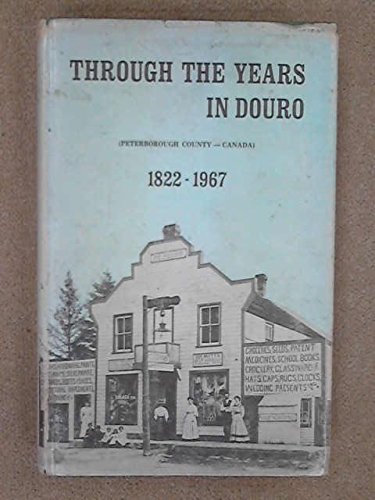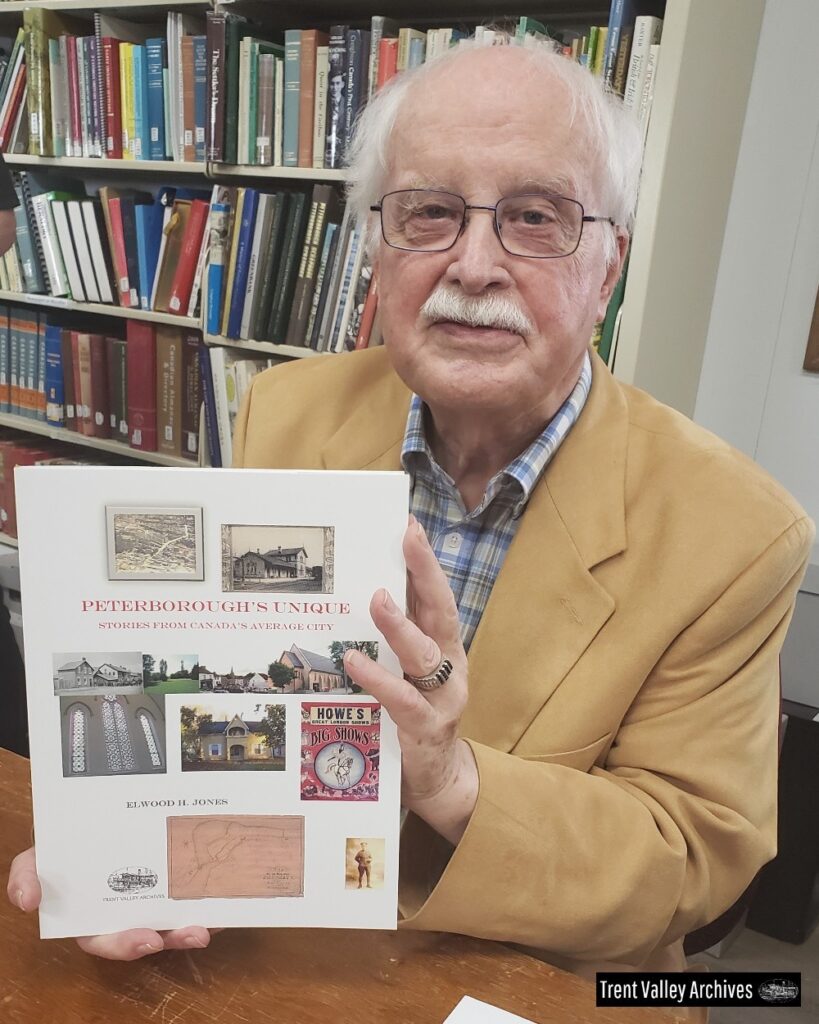
Through the Years in Douro published by the Centennial Committee of the Township of Douro
One of the oldest and still reliable township history, Through the Years in Douro, (1967 and other reprints) has useful information on the history of the Robinson emigration. Howard Pammett was the main source for this information and as the author of a 1933 Queen’s M.A. thesis on the emigration he knew the sources.
The book discusses Douro before 1825 in the opening chapter. It is a neat summary of what was believed before 1954, including quotes from Frances Stewart. The chapter includes discussion of the Stricklands, Traills, Stewarts and Reids and notes about 500 British settlers in the part of the Newcastle District above Rice Lake before 1825. He uses the 1851 census to calculate the number of Mississaugas at about 500 on the four key locations.
Chapter Two, “Robinson’s Irish Emigrant Settlers 1825”, was written by Mrs. D. Amos with added material from Mrs. Aileen Young, William Towns and Pammett. This is a useful summary but still reflects much of Pammett’s negativity towards Robinson. Robinson had been in the area by August, and the settlers arrived between September 1 and the end of October in about 60 scowloads navigating the Otonabee route. The narrative includes comments by Captain Basil Hall who visited in 1827, and by some descendants in 1933. The industrious farmers shaped Douro by 1850.
There is a chapter discussing hardships and achievements, using material from varied hands. Schooling, churches and social life before 1850 are discussed in separate chapters. This section of the book concludes with a discussion of Lakefield and the Lakefield Infantry Company which formed to deal with the Fenians of 1866.
The chapter on the Douro Centennial 1925 (chapter 23) took place 21 to 27 June 1925 and was a memorable occasion, also discussed by Rosemary McConkey in Green Routes (2022). P. G. Towns’s epic poem is printed here (194-195). It was written to encourage “old boys and girls” to come to Douro and “meet on the sod where your forefathers trod.” The week featured baseball and football games between neighbouring teams, track and field events, “Indians in war dress”, and classes taught by the oldest surviving teacher. In later chapters, Mrs. D. Amos and Mary Holland writes about P. G. and Mary Towns and their legendary country store.
There are several appendixes. The first contains the complete copy of the 1818 treaty between the Crown and several Chippewa First Nations representing the Eagle Tribe, Reindeer Tribe, Crane Tribe, Pike Tribe, Snake Tribe, White Oak Tribe, and “Principal Men of the Chippewa Nation of Indians inhabiting the back parts of the Newcastle District.”
The second appendix lists the “Irish emigrants located by Peter Robinson in Douro Township, Oct. 1, 1825”. In addition to the lot location there are notes on rations given the residents. (pages 221-227) together with comments by P. G. Towns (p. 228). Appendix 3, listing the land grants, purchases and locations in Douro, 1819-1835 includes Robinson immigrants. (p. 229-231). The book lists transactions with the Canada Company, 1829-1835. Trent Valley Archives has land records for Peterborough County, but generally recording activity after 1840.
Douro is named for the Douro River in Portugal. One of Wellington’s battles against Napoleon occurred along the Douro near Porto in 1809.
In a section called Douro Miscellany (pp 238 ff) there is an interesting observation by Andrew Pickens, an 1832 traveller. “Mr. Robinson’s emigrants are located on the front third of the township, … The settlers are exerting themselves in opening roads….” There are several interesting anecdotes related to the Hennessey, Nolan, Murphy, Tedford and other families. There is also an excerpt from the Examiner report on the 1925 celebration.
Appendix 6 contains statistics related to Douro beginning with information from the censuses from 1826 to 1961. Douro’s population peaked in 1860 and was not matched until 1960. Much of the decline was linked to the job opportunities in a steadily growing Peterborough.
Appendix 7 contains the names of officials and people serving on township councils.
Appendix 8 lists the Douro Centennial farms in 1966, as well as farms of Robinson settlers, Allen, Leahy and Moloney.
Appendix 9 contains excerpts from diaries kept by Robert Quarles Dench and William Moher.
Appendix 10 contains the list of Douro ratepayers as listed in Morrey’s Directory for 1887 (pp 283-288).
Appendix 11 lists the parish members who became priests and nuns.
Appendixes 12 and 13 are about education. It begins with G. Winder Smith’s account of the Grove School. There are some photos and complete lists of teachers in township schools compiled by Kevin Leahy.
Appendix 14 is about folk singers and songs. The songs were collected by Edith Fowke but were shared by Mary Towns (nee Cleary), John Leahy, and Martin Sullivan. Allan Kirby has written about Fowke’s song collecting career in Fowke Songs: Edith Fowke’s Search for Canadian Folk Songs (Trent Valley Archives, 2022).
Appendix 15 contains “Flashbacks” chosen by J. Alex Edmison. Appendix 16, “A Final Centennial Harvest” contains William Towns list of nonagenarians, and a list of buildings over 100 years old. There also articles about farming in Douro township. This includes a reprint of the Examiner coverage of the founding of Lakefield Portland Cement Works, Examiner, 7 December 1900. (p. 322),
The book includes a bibliography and index, both rare for local history books. This ambitious book was an amazing community project for Canada’s centennial. There have since been local histories on Lakefield, one by the Lakefield Historical Society and one by Gordon Young, Heritage Lakefield.
Book Information:
A local history of the Township of Douro, Ontario, located east of the city of Peterborough. Chronological chapters cover early pioneers, 19th century growth, and people, government, religion, education, and so on from 1900 to 1967. Illustrated with black and white photographs.
Published by: Centennial Committee of the Township of Douro.; First Edition (Jan. 1 1967)
Pages: 342
You can read preview this book through online archives window below, click the link button below to be taken to the archives to borrow and view the FULL book (you will need to register an account to borrow the full digital book).

| About the Blogger |
|---|
| Elwood Jones is a prominent Peterborough historian, esteemed member of Nine Ships 1825 Inc., Professor Emeritus of History at Trent University, and archivist at Trent Valley Archives. With a prolific career, Elwood has authored a dozen historical books, several pamphlets, and numerous articles, including over 300 columns for the Peterborough Examiner. He also serves as the editor of the Heritage Gazette of the Trent Valley and has been a long-time editor for the Peterborough Historical Society and the Canadian Church Historical Society. |
0 Comments